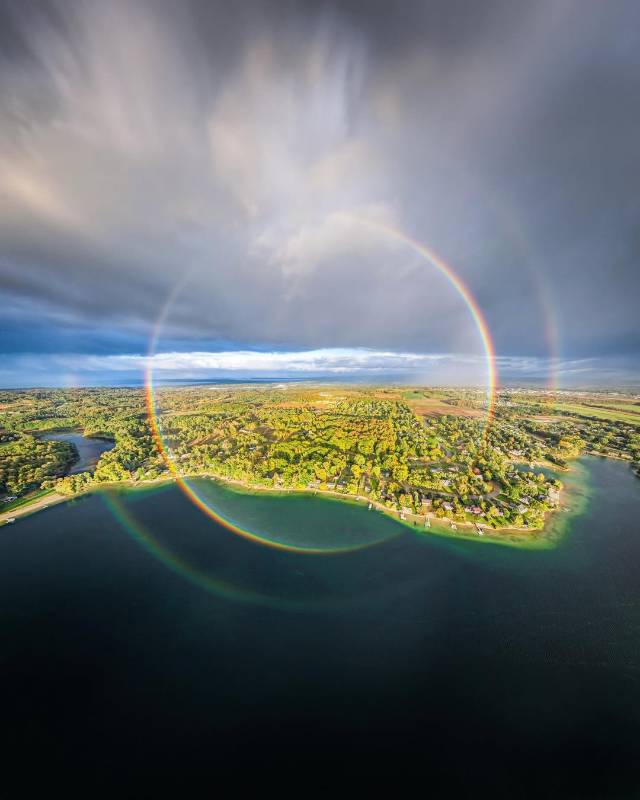Have you ever witnessed the magical phenomenon of a full-circle rainbow? While most of us are familiar with the classic rainbow arch that graces the sky after a storm, few have experienced the breathtaking sight of nature's most perfect optical display—a complete, unbroken circle of color suspended in the atmosphere.
The stunning photograph captured by drone over Michigan City showcases this rare and magnificent phenomenon in all its glory. Unlike the familiar semicircular rainbows we typically see from ground level, this aerial perspective reveals the rainbow's true form: a perfect circle of dispersed light. The image, which is actually a composite of twelve separate photographs, demonstrates both the technical skill required to document such ephemeral beauty and the scientific wonder behind its formation.
The Science Behind the Circle
Rainbows are always circular by nature—this fundamental truth often surprises people who have only observed them from the ground. The key to understanding this lies in the physics of light interaction with water droplets. When sunlight encounters suspended water droplets in the atmosphere, it undergoes a complex process involving refraction, internal reflection, and dispersion.
The process begins when white light from the sun enters a water droplet and slows down, causing it to bend or refract. As the light travels through the droplet, it separates into its component colors because different wavelengths bend at slightly different angles—a phenomenon known as dispersion. The light then reflects off the back surface of the droplet and exits, creating the spectrum of colors we recognize as ROYGBIV (red, orange, yellow, green, blue, indigo, violet).
The circular shape emerges because light exits the water droplets at a consistent angle of approximately 42 degrees relative to the incoming sunlight. This creates a cone of dispersed light with your eye at the tip, resulting in the circular rainbow pattern. Every point along this 42-degree angle from the antisolar point (the point directly opposite the sun from your perspective) contributes to the rainbow's formation.
Why We Usually See Only Half the Circle
From ground level, we typically observe only an arc because the Earth's horizon blocks the lower portion of the rainbow circle. The ground essentially acts as a visual barrier, preventing us from seeing the complete phenomenon. This is why rainbows appear as arcs during most observations—we're witnessing only the upper half of nature's perfect circle.
To see a full-circle rainbow, you need to be elevated above the point where the rainbow would typically meet the ground. This can happen from airplanes, tall buildings, mountaintops, or—as in the Michigan City photograph—from drones. The higher your vantage point, the more of the complete circle becomes visible.
The Secondary Rainbow: A Fainter Companion
The Michigan City photograph also captures another fascinating feature: a secondary rainbow that appears slightly lighter and positioned outside the primary rainbow. This secondary bow forms through a more complex light path involving two internal reflections within the water droplets instead of just one.
Secondary rainbows have several distinctive characteristics that set them apart from primary rainbows:
- They appear approximately 9 degrees outside the primary rainbow with a radius of about 51 degrees
- They are significantly fainter (about 43% of the primary rainbow's brightness) due to light loss during the additional reflection
- The color sequence is reversed, with red appearing on the inner edge and violet on the outer edge
- They are approximately 1.8 times wider than the primary rainbow
The dark band visible between the primary and secondary rainbows is known as Alexander's band, named after Alexander of Aphrodisias who first described it in 200 AD. This dark region exists because no light is scattered toward the observer at the angles between the two rainbow formations.
The Art of Composite Photography
The technical achievement behind the Michigan City rainbow photograph deserves special recognition. Creating a composite image from twelve separate photographs required precise timing, positioning, and post-processing expertise. This technique, known as image compositing, allows photographers to capture the full beauty of rapidly changing atmospheric phenomena that might be impossible to document in a single frame.
Composite rainbow photography presents unique challenges:
- Rapid atmospheric changes require quick capture of multiple frames
- Maintaining consistent exposure across all images while accounting for varying light conditions
- Precise alignment of images to create a seamless final composition
- Color matching to ensure natural-looking transitions between frames
This approach to rainbow photography demonstrates how modern digital techniques can reveal natural wonders that would otherwise remain hidden or incomplete in our visual records.
Understanding Supernumerary Rainbows
Sharp-eyed observers might notice additional faint bands of color appearing just inside the primary rainbow. These are called supernumerary rainbows—delicate fringes predominantly displaying green, pink, and purple hues. Unlike primary and secondary rainbows explained by geometric optics, supernumerary bows require understanding light's wave nature and interference patterns.
Supernumerary rainbows form when light waves from water droplets interfere with each other, creating regions where waves either reinforce or cancel each other out. These phenomena are most visible when raindrops are small and uniformly sized, typically around 1mm in diameter or less. The interference patterns create the characteristic closely-spaced bands that can change in number and intensity from moment to moment.
Photographing Rainbow Phenomena
For photographers hoping to capture their own rainbow masterpieces, several technical considerations prove crucial:
Equipment recommendations:
- Wide-angle lenses to capture as much of the rainbow as possible
- Polarizing filters to enhance color saturation and reduce glare
- Sturdy tripods for sharp images, especially important with slower shutter speeds
- Weather protection for equipment during the wet conditions that create rainbows
Technical settings:
- Narrow apertures (f/8 to f/11) for maximum depth of field
- Exposure bracketing to capture detail in both bright sky and darker foreground
- Fast enough shutter speeds to prevent motion blur from wind-blown droplets
Compositional elements:
- Position yourself with the sun behind you
- Look for interesting foreground elements to provide context and scale
- Consider the background—darker elements help rainbow colors stand out
- Time your shoot for optimal sun angles (typically when the sun is less than 42 degrees above the horizon)
The Broader Context of Atmospheric Optics
Rainbow phenomena represent just one fascinating aspect of atmospheric optics—the study of how light interacts with our atmosphere to create visual spectacles. This field encompasses numerous other phenomena including halos, sundogs, auroras, and mirages, each resulting from different interactions between light and atmospheric particles.
Understanding these phenomena enhances our appreciation of the natural world while demonstrating fundamental physics principles in action. From Rayleigh scattering that creates our blue sky to the refraction that produces mirages, atmospheric optics reveals the constant interplay between electromagnetic radiation and matter that surrounds us daily.
The Universal Appeal of Rainbows
Beyond their scientific significance, rainbows hold universal appeal across cultures and throughout history. They represent hope, promise, and natural beauty in mythologies worldwide. The scientific understanding of their formation doesn't diminish their wonder—rather, it adds layers of appreciation for the elegant physics that creates such beauty.
The Michigan City full-circle rainbow photograph serves as a perfect example of how modern technology can reveal hidden aspects of familiar phenomena. By combining aerial perspective with composite photography techniques, we can now document and share the complete glory of these atmospheric masterpieces.
Whether you encounter a rainbow as a simple arc after a summer shower or witness the rare spectacle of a full circle from an elevated vantage point, you're observing the same fundamental physics at work. Each rainbow serves as a reminder of the intricate beauty hidden within everyday natural processes—and the rewards that await those who take time to look up and marvel at the sky.
The next time you see a rainbow, remember that you're witnessing not just a beautiful optical display, but a perfect demonstration of light, water, and physics working together to create one of nature's most enchanting phenomena. And perhaps, if you're fortunate enough to find yourself with an elevated view during the right conditions, you too might witness the breathtaking sight of nature's perfect circle of light.


Discussion
Start the conversation
No comments yet
Be the first to share your thoughts on this article. Your insights could spark an interesting discussion!